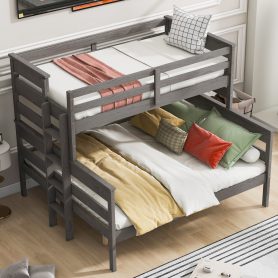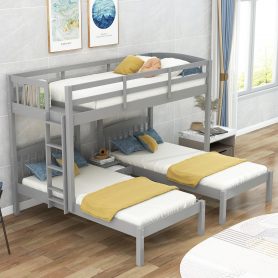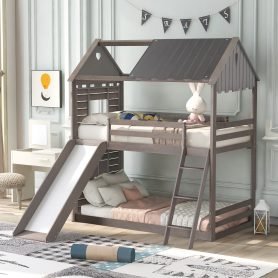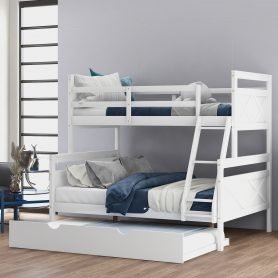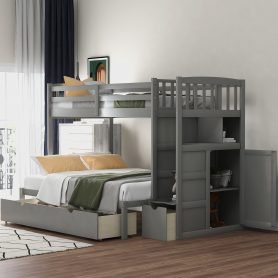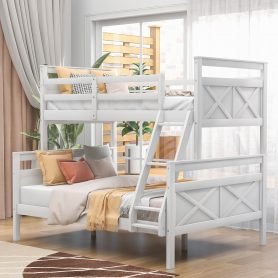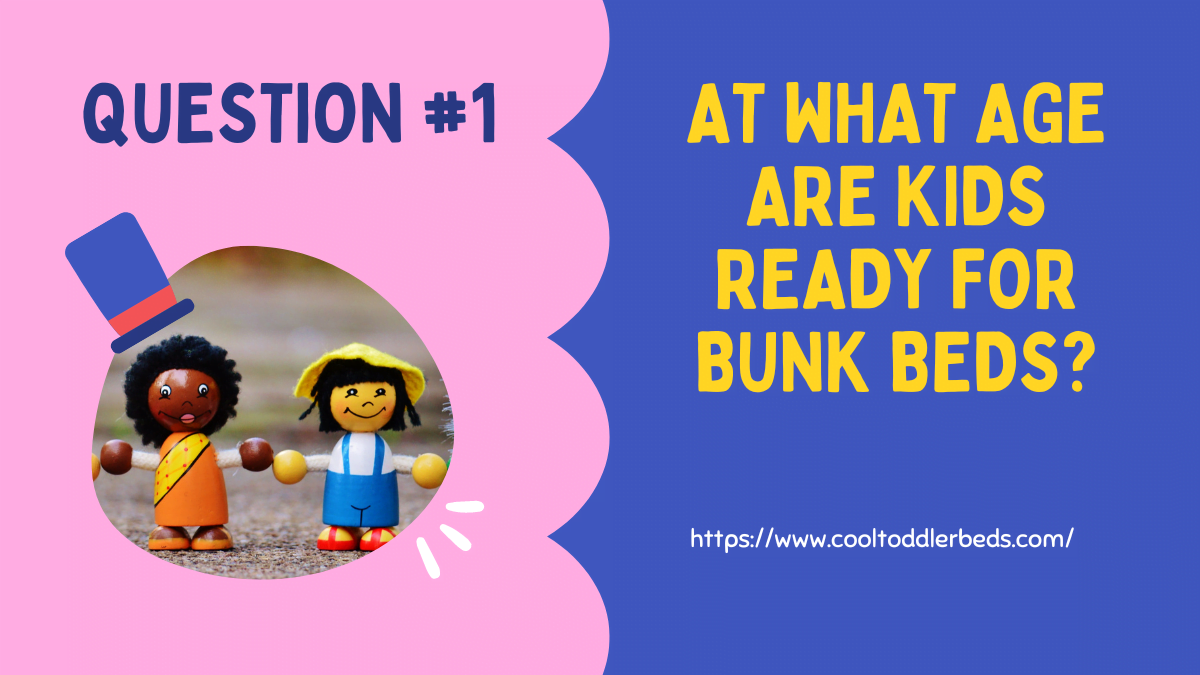
If you’ve ever been in a hostel, the military, or a dormitory, you’re probably familiar with bunk beds, two beds, one on top of the other.
The concept is simple and space efficient. These days, it seems to be more common in kids’ rooms. When looking for bunk beds, chances are most of them are in small sizes, suitable for kids of different ages.
Bunk beds are not suitable from an early age, though due to the potential risks associated with them, such as falls. So, when should you get one for your kid?
Long story short, kids under 6 years old shouldn’t use bunk beds or at least not the top bed. There isn’t any official guidance regarding the bottom bed, which is like a regular bed anyway and doesn’t require as much attention.
Dozens of thousands of people get into emergency rooms all across the USA for injuries related to bunk beds. Some of them involve mild bruises or cuts, but others can lead to life-changing injuries, such as cerebral concussions. Fractures are more common, though.
Nearly half of all the patients are kids under 6. Many injuries are mild and occur during playtime activities. Some others occur while asleep. Boys have more energy at a young age, so they’re more likely to get injured. While these issues are not severe, there’s always the risk of more significant dangers, such as strangulation or even suffocation.
These risks represent the main reasons wherefore parents shouldn’t allow kids under 6 on upper bunk beds. It’s mostly because of the lack of discipline and education in using these beds correctly.
Table of Contents
1. When is the right time to buy your child a bunk bed?
Most specialists agree that kids under 6 years old shouldn’t be allowed on top bunks. If you’re the paranoid type, wait until your kid is 9 years old, just to play it safe. By 9 years old, well-disciplined kids will follow the rules and education received regarding bunk beds, playing rules, and potential risks.
A bunk bed is often one of the best investments in a bedroom because it will save space and allow siblings to bond. However, a bunk bed is also a risky piece of furniture if kids aren’t well trained or quality standards are low.
2. Risks associated with bunk beds
No matter how practical they are, bunk beds can bring in some safety hazards as well:
- Lack of guardrails or improperly installed guardrails that can collapse and cause falls.
- Wrongly sized mattresses, causing falls if they’re too thick.
- Kids playing on the top bunk could fall or jump.
- Falling kids could end up on dangerous objects around beds.
- Ceiling fans are too close to the top bunks.
The risk of collapsing bunk beds
While quality bunk beds are made to last, improper installation could cause bunk beds to collapse. Even if assembled correctly, a bunk bed can collapse if the weight capacity is exceeded.
3. How old is too old for bunk beds?
Bunk beds are appropriate for any age as long as it is safe for the occupant to climb up and down the ladder. Different kids grow at different rates, so there’s no such thing as a general age. Older kids or adults may have no issues climbing bunk beds, but those with physical limitations may experience some problems.
For example, an old person with arthritis shouldn’t sleep in a top bunk. On the other hand, a senior with no mobility issues should have no problems climbing the bunk bed.
Adults shouldn’t use bunk beds for kids, though. If you like the idea, you can also find adult bunk beds. They’re larger and have a higher weight capacity.
4. Are bunk beds safe for toddlers?
Bunk beds can pose a series of risks to toddlers and especially the top bunk. There are no major guidelines or risks regarding lower bunks, but the top ones could cause some issues. Toddlers, kids ages 2, 3 or 4 shouldn’t be allowed at the top.
Even when buying bunk beds for older kids, there are some safety recommendations you should follow. For example, a trundle can prevent many of the risks associated with bunk beds, while still saving space and allowing kids to share a room. As for lower bunks, they are normally alright for toddlers, but it’s up to you to make a decision. There are no serious falling risks there, though.
5. How to tell if your child is ready for a bunk bed?
There is no one definitive answer to this question. Every child is different and will develop at their own pace. However, there are some general guidelines you can follow to help you decide if your child is ready for a bunk bed.
First, consider your child’s age. Most experts recommend that children be at least four years old before using a bunk bed. This gives them time to adjust to sleeping in a new bed and to develop the coordination needed to safely use the ladder.
Next, assess your child’s physical development. Can they climb up and down the ladder without assistance? Do they have any medical conditions that might make using a bunk bed dangerous?
Finally, consider your child’s temperament. Are they the type of child who is likely to be scared by sleeping in a higher bed? Or are they likely to be excited and eager to try it out?
If you think your child is ready for a bunk bed, talk to them about it and see how they feel. If they are excited and eager to try it, then go for it!
6. The benefits of bunk beds for kids.
Bunk beds offer many benefits for kids. They are a great space-saving option for small bedrooms, and they can also be a lot of fun for kids to sleep in. Bunk beds can help kids feel more independent, and they can also make bedtime more enjoyable.
There are a few things to keep in mind when considering bunk beds for kids.
First, bunk beds are not recommended for children under the age of six. This is because young children may not be able to climb up and down the ladder safely.
Second, it is important to choose a bunk bed that is the right size for your child. Make sure the mattress is the correct size so that your child will be comfortable sleeping in it.
Finally, be sure to teach your child how to safely use the bunk bed. Show them how to climb up and down the ladder, and how to use the rails if the bed has them. Also, make sure they know not to jump off the top bunk. With a little bit of planning, bunk beds can be a great addition to any child’s bedroom.
7. How to choose the right bunk bed for your child?
Many bunk beds will require assembly, but others allow a professional to get it done, or they’re ready to use straight away. Think about it first, do you have decent DIY skills to assemble it yourself?
Pay attention to the materials as well, as they can dictate how sturdy and durable the bed is. The same rule applies to both the frame and the mattress.
Think about your kids’ size, too and remember, they grow fast at this age.
Finally, go for good value for money. If you could, you should get a bed from a reputable brand on a special offer.
Since bunk beds come in so many shapes and sizes, you’ll have to consider both your kids’ sizes and the available space in the bedroom. Most commonly, you’ll find a twin over twin bunk beds. Other popular options include twin over full or full over full beds.
Knowing all the required sizes will help you choose the right type.
When it comes to materials and durability, you’ll usually have metal and wood. Metallic bunk beds are based on a tubular construction and won’t cost a lot, yet they can get squeaky in the long run. They’re quite durable though.
Just like metallic beds, wooden beds come in more materials. Many of them are more durable and a bit heavier than metallic beds, but they’ll also cost more. Pine, cherry, and hardwood are the best choices.
Keep in mind that you don’t necessarily have to start with a bunk bed. Sometimes, a trundle bed makes a good introduction to a bunk bed.
8. The safety concerns of bunk beds for kids.
When it comes to bunk beds, safety should always be a top priority. Here are some important safety considerations to keep in mind:
- Get guard rails on all sides, including the side by the wall.
- Guard rails should be 5 inches taller than the mattress.
- Keep the top opening for the ladder 15 inches in width or lower.
- Guard rails shouldn’t be installed more than a few inches above the bunk bed foundation.
- Purchase a mattress in the perfect size to avoid traps between the rails and the mattress.
- Educate your kids never to play on the bunk bed or ladder.
- The same goes for kicking or jumping, not to mention pushing.
- Each bunk bed should accommodate one child only.
- Kids must only use the ladder to get in and out of the top bunk.
- A mild nightlight should go by the ladder, so kids can see it in the dark.
9. What’s the best bunk bed for children?
There are lots of bunk beds to choose from, and each of them has its own pros and cons. Generally speaking, you want quality, value for money, and durability.
Harper and Bright wood bunk bed is one of the best-reviewed products online. It has a staircase, and a trundle and features the twin over twin construction. The top is suitable for the older kid, while the lower bunk is great for kids of all ages, including toddlers.
Compared to classic ladders, this bunk bed has a solid staircase, which is easier, more comfortable, and safer. There are also four storage drawers to hold blankets, books, or toys, not to mention the relatively tall guardrails.
On the other hand, the Storkcraft hardwood twin bed has a conventional ladder, a safety rail, and a solid construction. Based on rubber wood, it’s not just denser and more solid, but also more durable than other options.
Since guardrails are included, you won’t have to buy them yourself. The ladder is a bit angled for safety, so kids are less likely to fall while using it. Furthermore, this bed can be converted into two twin beds if your kids no longer like to use it as a bunk.
While you can also check our bunk beds, they also have quality and affordable prices:
-
 Wood Twin XL over Queen Bunk Bed with Ladder$440.49
Wood Twin XL over Queen Bunk Bed with Ladder$440.49 -
 Twin over Twin & Twin Bunk Bed with Built-in Middle Shelf$521.22
Twin over Twin & Twin Bunk Bed with Built-in Middle Shelf$521.22 -
 Wood Twin Over Twin Bunk Bed With Roof, Window, Slide, and Ladder$505.99
Wood Twin Over Twin Bunk Bed With Roof, Window, Slide, and Ladder$505.99 -
 Twin Over Full Bunk Bed With Ladder, Twin Size Trundle, Safety Guardrail$469.51
Twin Over Full Bunk Bed With Ladder, Twin Size Trundle, Safety Guardrail$469.51 -
 Twin over Full/Twin Bunk Bed$641.19
Twin over Full/Twin Bunk Bed$641.19 -
 Twin Over Full Bunk Bed With Ladder, Guardrail
Twin Over Full Bunk Bed With Ladder, Guardrail
10. Frequently Asked Questions
Still unsure about the best bunk bed for your kids?
Can younger children sleep in the bottom bunk?
Yes, younger children can sleep in the bottom bunk as long as they meet the size and maturity level requirements.
Are bunk beds safe?
Bunk beds can be safe as long as proper safety precautions are taken, such as using guardrails and teaching children how to safely use the bed.
Can bunk beds be used by adults?
It depends on the weight limit and size of the bunk bed. Some bunk beds are designed to accommodate adults, while others are not.
Are bunk beds safe for 4 year olds?
Kids younger than 6 should not sleep in the top bunk. If the lower bed is safe, there are no age restrictions there. In other words, bunk beds are safe for toddlers only if they sleep in the lower bed.
Can a 5 year old use a bunk bed?
Yes, but with some restrictions. The top bed is likely to pose some risks for a 5 year old, so only allow them to sleep in the lower bed. The top bunk is recommended for kids older than
Can a 12 year old sleep on the top bunk?
Absolutely, if the size is right. Make sure your kid hasn’t outgrown the size of the bed, not to mention the weight capacity. By this age, your kid should also know how to climb the ladder in a safe manner.
11. Conclusion
Bunk beds can be a great space-saving option for siblings sharing a room. However, parents need to be aware of the potential safety hazards associated with them, particularly for children under six years old.
Lack of guardrails or improperly installed ones, wrongly sized mattresses, and kids playing on the top bunk are just a few examples of the risks involved. It is recommended that children under six years old should not be allowed on the top bunk bed.
Parents should also ensure that their children are well-educated about using bunk beds correctly and follow safety guidelines such as installing guardrails on all sides and purchasing a mattress in the perfect size to avoid traps. By taking these precautions, parents can make sure their children enjoy their bunk beds safely and comfortably.

